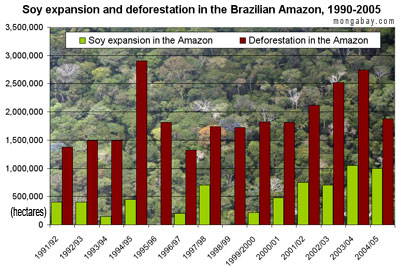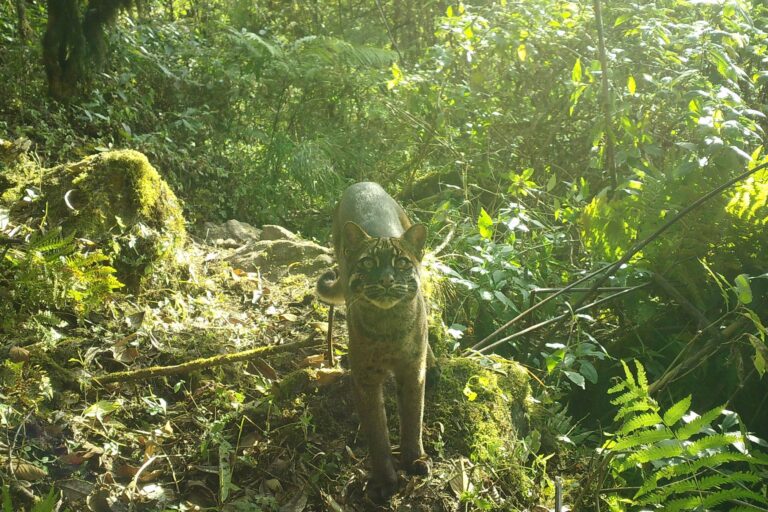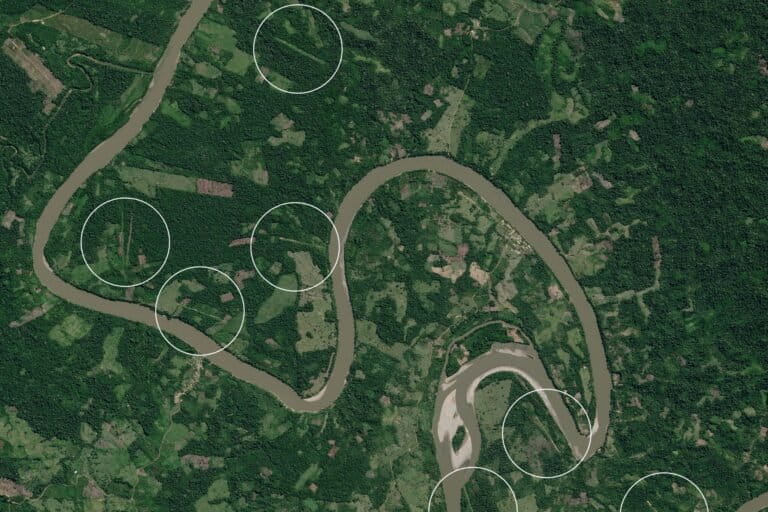Future threats to the Amazon rainforest
Rhett A. Butler, mongabay.com
July 31, 2008
Between June 2000 and June 2008, more than 150,000 square kilometers of rainforest were cleared in the Brazilian Amazon. While deforestation rates have slowed since 2004, forest loss is expected to continue for the foreseeable future.
Here mongabay.com takes a look at past, current and potential future drivers of deforestation in the Brazilian Amazon.
Please note, breaking news on the Amazon can be found at Amazon news.
Past drivers of deforestation in the Amazon
Most deforestation in the Brazilian Amazon has occurred since the late 1960s when the Brazil’s military government began to sponsor large-scale development programs to promote colonization in the region. The plan, which sought to provide economic opportunities for landless poor from crowded parts of the country and establish a national presence in the vast and sparsely populate interior, offered subsidized loans to settlers and ranchers, and funded ambitious highway projects like the Trans-Amazonian highway.
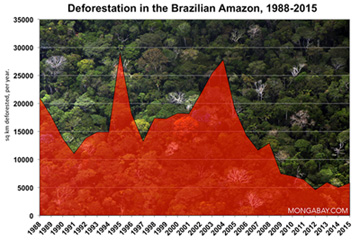
|
While the Trans-Amazonian largely failed to meet its economic and social goals, it did open up large tracts of previously inaccessible rainforest land to development. Vast stretches of land were cleared for low-intensity cattle pasture and short-term subsistence agriculture. Despite laws restricting land-clearing to 50 percent of a settler’s holdings, deforestation rates climbed from negligible to more than 20,000 square kilometers per year in the 1980s. Giant infrastructure projects — notably dams — partially underwritten by multilateral development banks also contributed to large-scale forest loss, while logging spurred the expansion of unofficial road networks and subsidized agricultural expansion.
As the colonization scheme waned and the economy weakened in the early 1990s, deforestation rates slowed. For the rest of the decade forest clearing largely moved in step with the economy as drivers of deforestation became more industrialized. Although clearing for cattle pasture continued to be the largest cause of forest conversion, the emergence of mechanized soy agriculture in the frontier states of Pará and Mato Grosso hinted at what the next decade held in store for Earth’s largest rainforest.
Current drivers of deforestation in the Amazon
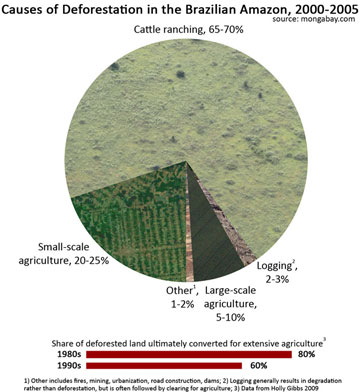
This pie chart is based on the median figures for estimate ranges. Please note the low estimate for large-scale agriculture. Between 2000-2005 soybean cultivation resulted in a small overall percentage of direct deforestation. Nevertheless the role of soy is quite significant in the Amazon, displacing small landholders who then clear virgin forest areas and providing “key economic and political impetus for new highways and infrastructure projects, which accelerate deforestation by other actors,” according to Philip Fearnside. It is also important to realize this is deforestation not degradation. Logging affects a much larger area but does not directly result in deforestation. |
Deforestation continues to be driven by the same factors as in the 1990s, though since 2000 annual forest clearing has shown an increasingly tight correlation to commodity prices, especially soy and beef, which have benefited from the near eradication of foot-and-mouth disease in cattle and agricultural innovation that has converted the region’s poor acidic soils into land suitable for extensive soy farms. As more Amazon land has come under agricultural cultivation, rising prices for commodities have served as an impetus for forest clearing. Expansion in the region has been promoted both by financial incentives — including subsidized loans — and Brazil’s ambitious $43 billion “Program for the Acceleration of Growth” (PAC), an initiative that is funding construction of roads, ports, pipelines, hydroelectric dams, and other infrastructure improvements. Under the PAC, large areas of the Amazon will be opened to development, improving the viability of soy, oil palm, logging, and beef production in once remote areas.
Cattle
Clearing for cattle pasture is the largest driver of deforestation in the Amazon, accounting for more than two-thirds of annual forest clearing in many years. Traditionally such land has been used for low intensity grazing, primarily as a vehicle for speculating on appreciating land prices, but this is changing. The recent influx of capital, combined with the eradication of foot-and-mouth disease and improved infrastructure, has lead to the emergence of intensive operations with six to eight times the number of cattle per hectare. These trends have spurred Brazil’s rise to become the world’s largest exporter of beef. Today the country has more than 200 million head of cattle and slaughterhouses in the Amazon account for more than 40 percent of production, according to a 2008 study by Amigos da Terra Amazônia Brasileira. 96 percent of growth in country’s herd size since the end of 2003 has occurred in the Amazon.
 The recent surge in soy and cattle prices could be driving an increase in forest fires. Annual deforestation figures for the 2007-2008 year will not be released until August of 2008. |
- Brazil seizes cattle illegally grazing on Amazon forest lands(6/25/2008)
- Amazon beef producer creates eco-certified meat product with help of scientists(6/8/2008)
- Brazil’s new environmental minister blames ranchers for surge in Amazon deforestation(6/3/2008)
- Cheap ranch loans may be driving jump in Amazon deforestation(2/12/2008)
- Can cattle ranchers and soy farmers save the Amazon?(6/6/2007)
Soy
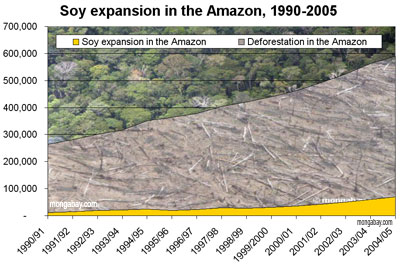
Soy expansion in the Brazilian Amazon, 1990-2005 Total deforestation and area of soybean cultivation across states in the Brazilian Amazon. Overall soybean cultivation makes up only a small portion of deforestation, though its role is accelerating. Further, soybean expansion and the associated infrastructure development and farmer displacement is driving deforestation by other actors. Note: some soybean farms are established on already degraded rainforest lands and neighboring cerrado ecosystems. Therefore it would be inappropriate to assume the area of soybean planting represents its actual role in deforestation.
Annual deforestation rates and annual soy expansion for states in the Brazilian Amazon 1990-2005. Note that the 1995-1996 and 1998-1999 years were negative and do not show up on the chart. Graphs based on Brazilian government data. |
Soybean cultivation in the Amazon has expanded rapidly in recent years due to improved infrastructure in the region and rising demand for vegetable oils for food, industrial uses, and biodiesel production. Since 1990 the area of land planted with soybeans in Amazonian states has expanded at the rate of 14.1 percent per year (16.8 percent annually since 2000) and now covers more than eight million hectares. While the Amazon’s largest soy crushers have had a ban on soy produced from newly deforested lands sine July 2006, soy is nonetheless seen as an important indirect driver of deforestation in the Brazilian Amazon by driving up land prices and creating an impetus for infrastructure improvements that promote forest clearing. In areas where soils and topography are suitable for mechanized soy cultivation, rainforest lands are typically cleared for low-intensity cattle ranching then sold to soy producers some two to three years later. Ranchers then move into frontier areas, spurring deforestation.
- Biofuels, food demand may doom tropical forests (7/14/2008)
- Amazon soy moratorium extended; may be expanded to other products (6/23/2008)
- Global Commodities Boom Fuels New Assault on Amazon (6/20/2008)
- ‘Soy King’ says Amazon deforestation could help solve global food crisis (4/28/2008)
- Amazon soy ban seems to be effective in reducing explicit deforestation (4/3/2008)
- U.S. biofuels policy drives deforestation in Indonesia, the Amazon (1/17/2008)
- Brazil bans illegal soy and cattle production in the Amazon rainforest (12/24/2007)
- China urged to join sustainable soy efforts in the Amazon (9/12/2007)
- More on Amazon soy
Small-holder clearing
Land-clearing by small-holders remains a significant source of new deforestation in the Brazilian Amazon. Despite the federal government’s recent efforts to rein in deforestation in the so-called “Arc of Deforestation”, at the same time it actively promotes colonization in the Amazon. Agencies including INCRA and SUFRAMA resettle thousands each year who then clear forest for subsistence agriculture or to sell to developers.
Logging

|
Logging continues to be a key component of land use change in the Brazilian Amazon. While outright deforestation via clear-cutting for timber is rare in the Amazon due to the dispersed nature of valuable trees, timber-harvesting leads to large-scale degradation of forests in the region. It is estimated than the area logged each year in the Amazon can exceed the extent that is deforested. Logging also significantly increases the likelihood that forest lands will eventually be cleared for other uses, including small-scale agriculture, industrial farms, or cattle pasture. Logging in fact often subsidizes subsequent development activities.
- Brazil to send more police into the Amazon to fight illegal logging (7/23/2008)
- Amazon timber industry declares ban on illegal logging (7/18/2008)
- 20% of Amazon timber illegally harvested from protected areas (7/7/2008)
- EU may mandate certification system for Amazon timber (6/20/2008)
- 40 arrested in illegal timber raid in the Brazilian Amazon (5/29/2008)
- Selective logging leads to clear-cutting in the Amazon rainforest (7/31/2006)
- Logging impact worse than thought in the Amazon (11/1/2005)
Plantations
Amazon rainforest is sometimes cleared for the establishment of plantations pulp and paper, timber and fiber production. In 2006 Brazilian firms planted 627,000 hectares of industrial forest plantations, an increase of 13% from 2005.
Mining
Mining in the Brazilian Amazon presently results in limited deforestation due to crackdowns on informal miners known as garimpeiros. The pig iron industry may have the largest role in mining-driven deforestation by consuming wood to produce charcoal to fuel steel production.
In Peru and adjacent countries, booming mineral prices are driving an expansion of mining activities.
- High mineral prices drive rainforest destruction (8/13/2008)
- Scientists call for mining ban, new protected areas in Suriname (6/21/2008)
- France blocks controversial rainforest gold mine in French Guiana (2/6/2008)
- Pig iron production fueling Amazon deforestation (9/21/2005)
- Steel production drives deforestation in Brazil’s Pantanal (2/11/2008)
- No sacrifices to ending deforestation in the Amazon, only gains (4/29/2008)
(4/29/2008)
Oil and gas development
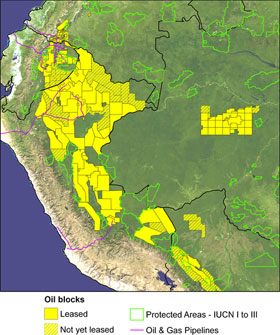 Oil and gas blocks in the western Amazon. Solid yellow indicates blocks already leased out to companies. Hashed yellow indicates proposed blocks or blocks still in the negotiation phase. Protected areas shown are those considered strictly protected by the IUCN (categories I to III). Image courtesy of PLoS ONE |
Oil and gas development is emerging as a major threat in the western Amazon, particularly in the countries of Colombia, Ecuador, Peru (72 percent of the Peruvian Amazon in under concession), and Bolivia, and to a lesser extent, Brazil. In August 2008 a paper published in PLoS ONE showed that 688,000 square kilometers (170 million acres) of the western Amazon is presently under concession for oil and gas development. Some of the blocks overlay indigenous reserves and protected areas.
Oil and gas development typically impacts tropical forests through pollution and by promoting road-construction, which in turn, facilitates deforestation, colonization, and illegal logging, mining, and hunting.
In late 2007 Brazil’s Petrobras announced plans to explore remote parts of the Amazon for oil.
- Oil development may destroy richest part of the Amazon rainforest (8/12/2008)
- Chevron lobbies Bush Administration for bail out on lawsuit by Amazon tribes (7/31/2008)
- Brazil to search for oil in the Amazon (10/21/2007)
- Ecuador looks for payments to leave oil in the ground (5/25/2007)
(4/29/2008)
Hunting
While hunting doesn’t result in deforestation, it can have an impact on the ecology of the forest. The massive volume of wildlife taken from the Amazon each year — much of which is harvested to meet market demands rather than local consumption — has resulted in “empty forests” in some regions. Forest fragments and areas near logging camps and mining sites are particularly affected.
- Commercial hunting may be largest threat to rainforests (4/30/2007)
- Subtle threats could destroy the Amazon rainforest (11/7/2007)
As global demand grows for agricultural commodities produced in the Amazon, the region is being increasingly affected by drought, fragmentation, and forest fires, all of which are exacerbated by climate change. The synergistic impact of these forces, coupled with the emergence of new feedstocks, the entrance of oil palm development, and continued expansion of infrastructure, loom large for the future of Amazonia.
The future of Amazonia
Markets

Agricultural potential for soy, palm, and sugar cane in the Brazilian Amazon (top). Carbon storage on forest lands suitable for various crops (bottom). Derived from the Woods Hole Research Institute’s Readiness For REDD: A Preliminary Global Assessment Of Tropical Forested Land Suitability For Agriculture. |
The reasons for land-clearing in the Amazon are compelling: cheap land and booming demand for commodities driven by a surging China and growing interest in biofuels. These factors have helped Brazil become an agricultural superpower — the world’s largest exporter of beef, cotton, coffee, orange juice, soybeans, and sugar, among other products — in less than a generation. Amazon landowners have seen their land values double every 4-5 years in areas that just a decade ago were pristine rainforests. The market is driving deforestation and will continue to drive deforestation into the future, although two new developments could accelerate the process: oil palm and next-generation biofuels based on cellulosic ethanol technology.
Amazon palm oil
The announcement in July 2008 that Malaysia’s Land Development Authority FELDA would establish 100,000 hectares (250,000) of oil palm plantations in the Brazilian Amazon came little surprise — 2.3 million square kilometers of the Brazilian rainforest are suitable for cultivation of the edible oil crop. Presently little commercial palm oil is produced in the region due partly to the traditional nature of Brazilian farmers and pest concerns, but the entrance of industry-leading Malaysian producers could serve as a model and quickly increase palm oil’s visibility as a viable form of land use. As the world’s highest yielding mass market oilseed, palm oil will likely offer better financial returns than cattle ranching and mechanized soy farms, the dominant agricultural activities in Brazilian Amazon, and will employ larger numbers of people (oil palm plantations may employ roughly one worker per 8-10 ha, whereas a single cowboy can handle 4,000-5,000 head of cattle grazing hundreds of ha of land). Oil palm expansion in the Amazon will likely be facilitated by infrastructure projects currently underway in these region, including road-building, port expansion, and new hydroelectric projects. Oil palm producers may also benefit from a “logging subsidy” whereby timber harvested from a tract of land helps offset the cost of establishing a plantation. Before the recent run-up in palm oil prices, logging had been a key element to the profitability of oil palm plantations in Southeast Asia.
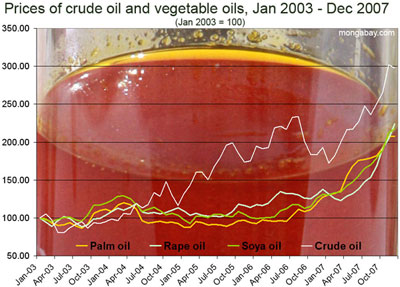
Market prices for crude and vegetable oils from January 2003 through December 2007. Data derived from FAOstat and the World Bank. |
Cellulosic ethanol
Although cellulosic ethanol is not yet a reality, biotech companies are spending large sums of cash on research and development. Once the technology is perfected, the Amazon could well be an early victim of the initial wave of large-scale forest conversion for energy feedstock. Assuming a yield of 70 gallons of ethanol per ton of dry biomass, razing the rainforest as feedstock could generate 15,000 gallons of ethanol worth $30,000-40,000 per hectare. A million-hectare lot could generate $7 billion in profit. The land could be replanted with fast-growing feedstock for future production.
- Cellulosic energy may trigger dramatic change in the Amazon (3/11/2008)
- Next gen biofuels could decimate rainforests (5/27/2008)
The big picture
On a historical basis the Amazon has proved to be resilient to climate change, large-scale human disturbance by pre-Colombian populations, and even periods of fire and extreme drought during millennial el Niño-like events. Nevertheless, the present onslaught of forces affecting the Amazon is unprecedented. Never before has the region experienced the simultaneous impact of large-scale forest loss and degradation, fragmentation, forest fires, and climate change.
Scientists are working to understand the potential impact of climate change on Earth’s largest rain forest. Some models suggest parts of the Amazon will experience elevated temperatures and less rainfall, while other regions will get more rain, but the debate is far from settled when it comes to predicting the sensitivity and responsiveness of the region’s ecosystems to elevated CO2 levels.
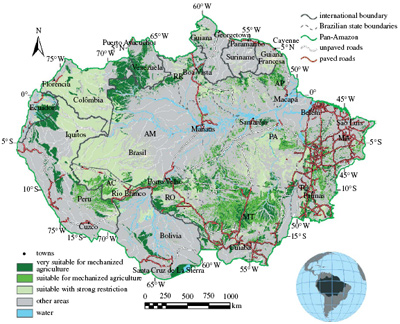 Soil suitability map for mechanized agriculture in the Pan-Amazon region. Restrictions include slope (more than 2%), inundation risk and poor soil (ultisols, hydromorphic soils, sands and lithosols). Map from Nepstad et al (2008). |
The little that is known about present change in the Amazon is little cause for comfort. Giant clearings created by cattle pasture and soy farms suck moisture from surrounding forest fragments, while winds blow down trees, thinning the canopy and allowing sunlight to reach the forest floor. This dries leaf litter and kills trees. Dying trees drop leaves and branches, creating tinder for knee-high surface fires that burn through the forest as they escape from nearby agricultural clearings. While these fires are small, they cause significant damage in an ecosystem not well adapted to fire. Three recurrent fires over a several year period can completely obliterate the forest.
As vegetation goes up in smoke, the forest’s own rain-generating capacity is reduced — as much as half the moisture in some parts of the Amazon is recycled through evapotranspiration. Fewer trees mean less rainfall, while the heavy smoke from burning has been found to inhibit cloud formation and reduce rainfall. These effects are not limited to local areas. Research led by Roni Avissar of Duke University suggests that changes in the Amazon may have an even wider impact, with deforestation influencing rainfall from Mexico to Texas and the Gulf of Mexico.
How these changes will compound and affect the Amazon in the long-term is still unclear — some projections are dire, others less so. But all raise concern for those seeking to conserve the forest.
 A map of Amazonia 2030, showing drought-damaged, logged and cleared forests assuming the last 10 years of climate are repeated in the future. See text for further details. PPT, precipitation. Map from Nepstad et al (2008). |
In 2003, a simulation by Peter Cox and his colleagues at the Hadley Center for Climate Prediction and Research provoked alarm and controversy when it forecast significant “die-back” of the Amazon rain forest by mid-century and a virtual collapse of the ecosystem by 2100. The projection, which evaluated only the impact of increased atmospheric carbon dioxide concentrations on temperature and precipitation in the region, has since been eclipsed by models forecasting an even more accelerated path due to interaction of climate and land-use change. Research published earlier this year by Daniel Nepstad and colleagues forecast that 55 percent of Amazon forests will be “cleared, logged, damaged by drought, or burned” in the next 20 years if deforestation, forest fires, and climate trends continue apace. The damage will release 15-26 billion tons of carbon into the atmosphere, adding to a feedback cycle that will worsen both warming and forest degradation in the region. Worryingly, Nepstad says this scenario is a conservative one — forest loss and emissions could be far worse.
Nepstad and other scientists point to the 2005 drought as the direction the Amazon may be headed. That drought, which has recently been linked to warming in the tropical Atlantic rather than to El Niño, was the worst in memory. As rivers dried up, remote communities were isolated and commerce slowed to a standstill. Thousands of square kilometers of land burned for months, releasing more than 100 million metric tons of carbon into the atmosphere.
- Global Commodities Boom Fuels New Assault on Amazon (6/20/2008)
- Half the Amazon rainforest will be lost within 20 years (2/27/2008)
- Deforestation a greater threat to the Amazon than global warming (2/25/2008)
- Amazon rainfall linked to Atlantic Ocean temperature (2/25/2008)
- Large-scale Amazon deforestation or drying would have dire global consequences (2/21/2008)
- Global warming – not el Nino – drove severe Amazon drought in 2005 (2/20/2008)
- 55% of the Amazon may be lost by 2030 (1/23/2008)
- Global warming accelerates destruction of the Amazon (12/6/2007)
- Globalization could save the Amazon rainforest (6/3/2007)
While it may seem inevitable that much of the Amazon will be burned, plowed for cattle pasture and industrial soy farms, or turned into savanna by climate change, emerging trends suggest there is reason to believe the Amazon can avoid the worst. In a future beset with uncertainty over the looming impact of global warming and massive shifts in the international economy, it is these same drivers that could hold the key to the Amazon’s salvation.
Part II (Solutions) to come
Breaking news on the Amazon rainforest



